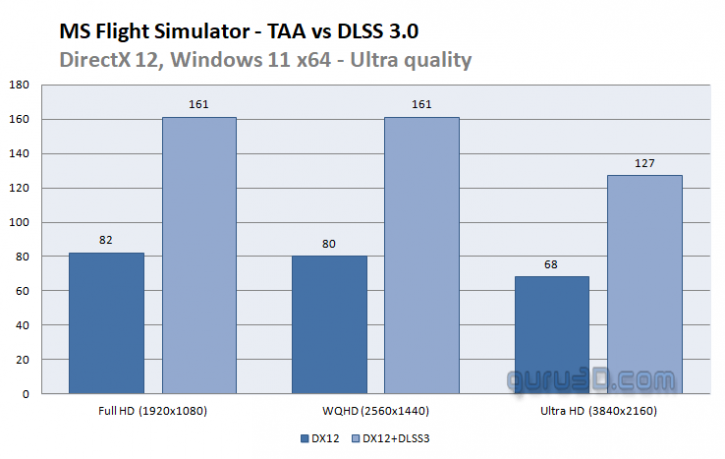(Raytracing + DLSS2/DLSS3)
Raytracing + DLSS2 or DLSS3
In addition to Raytracing results, we need to consider the performance gains obtained using technologies such as DLSS. It is no longer practical to evaluate all games in this manner due to the additional data sets and necessary time needed for measurements. Example; if we need to test ten games at three different resolutions, we will need to run approximately 30 benchmarks. Raytracing each game adds another 30 test runs, and then further results from sets with DLSS, for example, add another 30 test runs on top of that. For technologies such as Raytracing, FSR, and DLSS over the past two years, the data sets have increased from 30 test runs to nearly 100 test runs. As a result, we've chosen a representative number of rasterized DX11/12 games, a couple of pure raytraced games and then included some FSR and/or DLSS results on this separate page for comparison. We'll first look at traditional DLSS 2.0 before we dive into the magnificence that is DLSS 3.0
DLSS 2.0
DLSS 3.0
Believe it or not, DLSS3 is where new and astounding performance will happen. We don't have heaps of results just yet but first, let's take the DLSS test from 3DMark to get a general idea:
The baseline non-DLSS result set of the test is based on raytracing and ends at 40 FPS on average. As you can see, DLSS3 offers an almost 2.5x performance increase. Our target render resolution for all tests here is 3840x2160 (UHD). So yeah, performance is the potential that DLSS3 offers. But let's move on to a game.
We received a beta press build from NVIDIA that already has DLSS3 support; DLSS2 does not seem to be optimized well. We measure a jump from 45 FPS with a GeForce RTX 4080 towards ~103 FPS; that's incredible. And if you are wondering, this is what Raytracing-enabled Cyberpunk with DLSS3 looks like at Ultra HD, have a peek where we walk around in the Ripperdoc.
Above: Raytracing and DLSS3 enabled
We had some more pre-release builds available; check out F1 2022 will get updated to DLSS3.0; again, Raytracing is enabled. The magic is happening with the new DLSS Frame generation feature. It seems it can solve the more considerable Software/CPU limitations (bottlenecks) your PC has.
Above: Raytracing and DLSS3 enabled
The pièce de résistance then ...we received a pre-build supporting DLSS3 and DLSS Frame generation of Microsoft Flight Simulator in DX12. The last time I tried this game I was hovering at 35~44 FPS in Ultra HD with an RTX 3090. The raw shader performance of the GeForce RTX 4080 pushes this to 68 FPS in UHD. But then, the real magic; below, we have also added a video have a peek. The results are outstanding. We're flying around in Ultra HD at 100~125 FPS effortlessly, the scenery is stunning with ultra-quality settings. All resolutions show the same framerates, meaning there's a huge bottleneck somewhere. Still, you cannot complain; that's over 2x performance with the flick of a switch.
Above: Microsoft Flight Simulator and DLSS3 enabled
Above: based on user request, we are adding some of the weightiest and most problematic to render airports and cities above Los Angeles, LAX airport. Microsoft Flight Simulator DX12 and DLSS3 enabled. Guys, I am not a pilot, so I am doing my best here. At one point, I'll enable the AI autopilot.
Above: based on user request, we are adding some of the weightiest and most problematic to render airports and cities above JFK. Microsoft Flight Simulator DX12 and DLSS3 enabled. Guys, I am not a pilot, so I am doing my best here. We'll do some low-ground passes, as the render engine hassles the most with that. At one point, I'll enable the AI autopilot.
Typically these cities/airports bring the sim to a crawl. JFK was quite possibly the most dreadful to render scenery. It will have stutters and slowdowns until you are way up in the air. This is game-related, not the graphics card. Here is a small tip to flight simmers, before you hit that fly now button, wait a while and let things cache.







